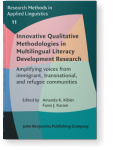Chapter 7
Bridging language and STEM
Using an Anzalduan framework to center Latinx Elementary and
Middle School students’ understanding of robotics
This chapter illustrates how combining an Anzalduan
framework with critical ethnography and social semiotics provides a
unique approach centering Latinx students’ STEM knowledge, language,
and literacy use as legitimate ways of conocimiento
and communicating. Using longitudinal data, authors examine how
Latinx middle-grade students use their linguistic repertoires
through multimodal representations to bridge their understanding of
a real-world STEM FIRST LEGO League (FLL) challenge and their
community, conceptualized through Anzaldúa’s (Moraga & Anzaldúa, 1983) work on
mestizaje and imagery of the
mestiza body as a bridge. The chapter further
documents how to rethink Anzalduan theory through overlaying Deleuze and Guattari’s
(1980/1987) characteristics of a minor
literature as an additional lens to deterritorialize
language and promote equitable research centering Latinx ways of
languaging, knowing, and being.
Article outline
- Introduction
- Overview of the study and its findings
- Traditional and critical ethnography in education
- Multimodal literacies
- Aims of the study
- Research context and participants
- Findings
- The mestiza(o) body as a bridge
- Bridging identity, language, and lived experiences
- Bridging farm workers toil to fork through multilingual and multimodal literacy practices
- Methodological discussion: Rethinking theory for more equitable
research
- Our mestizaje
- Thinking with theory
- Deterritorializing language through enacting the brown body
as bridge
- Deterritorializing language through multimodal
literacies
- Deterritorializing language through translanguaging
- Political immediacy and collective assemblage
- Connecting to Nepantla
- Implications for qualitative research on multilingual literacy
development
- Thoughts on ethical reflexivity
- Reconceptualizing qualitative research
-
References
This content is being prepared for publication; it may be subject to changes.
